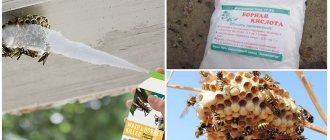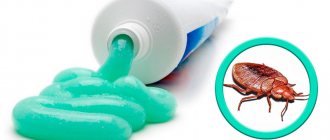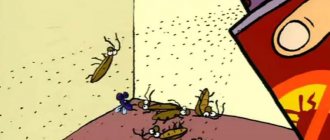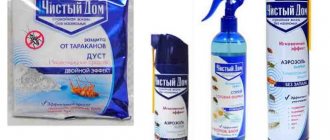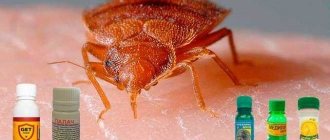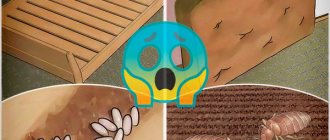Numerous studies lead scientists to the conclusion that in the fight against bedbugs, it is not so much the source and origin of the smell that is important, but its intensity. Even in experiments with human odor, too much of it repelled pests, while the low, barely perceptible aroma for insects, on the contrary, attracted. The odorous substances that caused noticeable changes in the behavior of bed bugs belong to the class of aldehydes, that is, alcohols. These may include:
- Octanal
- Nonanal
- Decanal
- Sulkaton
- Heptanal
All of these alcohols are found in the essential oils of various plants, so when it comes to scent repelling pests, the lion's share of products are related to aromatherapy, although there are some other substances that can also create a sharp, concentrated aroma that can affect house bugs. What kind of smells repel bedbugs and how to use them correctly so that the effect is noticeable?
Before moving on to considering specific compounds, it will be useful to understand how bedbugs generally breathe and perceive odors. This will help you understand the general principle of the method and avoid mistakes during its application, which can reduce the effectiveness of the entire procedure.
How do bedbugs breathe?
Bedbugs do not have lungs, but nevertheless they require oxygen to survive, albeit in very small quantities. Insects breathe through a special system of tubes branched throughout the body - tracheas. The exits of the trachea to the outside, where air is captured from the outside, are located on the abdomen of the insect. Thus, the mouth of a bedbug is a completely separate system of the body, which is in no way connected with its breathing, and the pest does not have a nose in principle.
How do bedbugs smell?
The perception of odors in bedbugs occurs not through the respiratory system, but through the olfactory sensilla. They look like microscopic hairs that cover the antennae and some areas of the insect's head. Decoding impulses, on the contrary, occurs in exactly the same way as in mammals. The sensilla contact odor molecules and send a nerve signal to the brain, where it is deciphered and interpreted.
Interesting fact
Laboratory studies have shown that bedbugs search for people indoors primarily by heat and carbon dioxide emissions. They are able to accurately detect odors from a distance of up to 1 meter. It was also found that bedbugs are attracted to unwashed clothing and bedding, which apparently have human odors on them.
Folk remedies
In addition to using herbs against parasites, folk remedies include several effective recipes from improvised products:
- Mix baking soda and vanillin in equal proportions. Scatter the resulting powder in secluded places, potential locations for bedbugs.
- Combine salt (4-5 tablespoons) with vanilla, in the amount of one dessert spoon. Pour the mixture under sofas, beds, carpets, and behind baseboards. Leave for 2-3 hours, then vacuum. Even after cleaning, the room smells pleasant to humans, but unbearable to insects.
But bedbugs are not at all afraid of garlic, despite its pungent aroma.
What smells do bed bugs hate?
Bedbugs do not like strong, concentrated odors, and one of the accessible and simple ways to create them and at the same time still have the opportunity to exist in the same room is to use oils and those parts and elements of plants that contain them. So, what smell do bed bugs hate?
Cinnamon
Cinnamon contains the phenol eugenol, cinnamaldehyde and benzyl benzoate. You can use cinnamon in different forms, for example in dried inflorescences or sticks, not only in the form of oil, which allows you to localize the aroma, making it noticeable to bedbugs and almost invisible to yourself.
Lemongrass
Lemongrass contains limonene, like citrus oils, as well as citronellol, which is a component of citronella oil. The latter is used in outdoor candles to repel mosquitoes and mosquitoes. The combination of these two ingredients can also affect bedbugs.
Carnation
Cloves have a sharp, very specific odor that is quite heavy in high concentrations. This may not be particularly pleasant for people, but it is what is needed in the fight against bedbugs. The effect on insects is achieved due to the composition of eugenol, which is found in large quantities in plants of the myrtle family.
Ylang-Ylang
The oil of the Ylang-Ylang tree, or otherwise fragrant cananga, contains substances related to heptanal alcohols, due to which it becomes possible to repel pests.
Mint
In peppermint, terpenes, alcohols and menthol provide the repellent effect. The plant has a pleasant, unobtrusive aroma for most people, but can have an intense stimulating effect on pets, especially cats.
Lavender
Lavender contains linalool, which has also proven itself as a repellent against moths, mosquitoes and even cockroaches. This compound is sometimes included in commercial insect control products. It has a calming effect on humans and is suitable for use in the bedroom.
Thyme/oregano
In thyme and oregano, carvacrol, thymol and α-terpinene have a repellent effect. The oils of these herbs have one of the easiest aromas to perceive, although the actual sensation will of course depend on each person's individual sense of smell.
Tea tree
Tea tree oil has a colossal number of useful properties that can be used in everyday life, including repelling insects. The terpinene contained in it is responsible for this effect. To enhance the intensity of the original scent, tea tree oil can be mixed with water and a small amount of 9% table vinegar.
Eucalyptus
Contains menthoglycol, which prevents insect sensilla from adequately perceiving odors, navigating in space and finding food. It has a very sharp, contrasting smell.
Orange
D-limonene, which is part of the oil of orange and a number of other citrus fruits, has a pronounced aroma and a proven repellent effect. Its concentration in fresh fruits can reach 90%. Citrus aromas have an invigorating effect on humans.
note
In all the above examples, we are talking specifically about natural essential oils, which actually contain the necessary components. Synthetic analogues may contain completely different substances. Such “oils,” hypothetically, can also have a repellent effect due to the intensity of their odor, but in this case there is no longer any need to talk about naturalness. Laboratory verified data only applies to real essential oils extracted from plants.
Neem oil
Neem tree oil, which in Russia is currently sold mainly as a cosmetic, is also an effective remedy for combating more than 200 species of insects. Azadirachtin and a number of additional components included in its composition can not only effectively repel parasites, but also, upon direct contact, kill young individuals whose protective chitinous covers have not yet hardened. Neem oil should be used at least once a week.
Alcohol
Another odorous product that can even kill bedbugs in an apartment, but only with abundant, targeted, direct contact with their body. This option works best on young individuals with soft covers. The alcohol smell also repels pests, but the problem with ethyl and isopropyl alcohol is that it dissipates very quickly. You can count on it only with regular use. For example, if you wipe surfaces with it several times a day.
Important
Any smells only repel bedbugs. With their help, it is impossible to get rid of a colony in the entire apartment. To really forget about insects for a long time, you need more radical methods that can kill them. Otherwise, you will simply continue to live with bedbugs together, at best receiving a temporary decrease in their activity.
Tansy
Another type of plant that can repel bed bugs is tansy. This is a fairly common meadow plant with small yellow flowers collected in clusters of inflorescences. A decoction of tansy is actively used by gardeners and gardeners to treat crops against pests. For many insects, tansy is poison.
However, tansy is unable to destroy bed bugs, since these insects do not eat grass, but feed only on human blood. Of course, if an individual gets into the tansy decoction, it will most likely die.
In this case, a substance poisonous to the insect will enter the insect’s body through the respiratory tract. However, simply inhaling the air in which the smell of tansy is in the air will not kill the insect.
Tansy, like wormwood, acts on bedbugs as a repellent, that is, the grass does not kill blood-sucking insects, but repels them. Thus, the herb helps provide household members with a restful sleep at night for some time.
How to use scents to control bedbugs at home
The source of most odors that repel bedbugs are aromatic oils, however, they can be used at home in different ways.
Sprays
Scented sprays are one of the most popular ways to use essential oils. Typically, up to 20 drops of oil are added to a 0.5-liter bottle of liquid, the mixture is shaken, and then applied through a spray bottle to surfaces, objects and areas where it is necessary to leave a pest-repellent aroma.
You can use not only one specific oil, but also create compositions from several ingredients. For example:
- Water + 10 drops lavender + 6 drops lemongrass + 6 drops tea tree + 10 drops thyme.
- Vodka (0.5 liters) + 15 drops of lavender + 15 drops of eucalyptus + 15 drops of tea tree.
- Alcohol 70% and above (0.5 liters) + lemongrass + cloves + lavender + thyme - only 20 drops each.
Before using any such homemade spray throughout your entire apartment, make sure that the smell is pleasant to you and tolerable to everyone living with you. Surfaces that absorb moisture can be saturated with aromas for a very long time; this is important to consider when using oils in any way.
Direct application to surfaces
Applying essential oils directly to surfaces undiluted is a radical approach that should be used with caution, especially on visible areas and materials that absorb and retain odors. It is most suitable for emergency lubrication of cracks, cracks and hard-to-reach places, although a much more effective measure would be to seal these cracks and cavities during repairs.
Cotton pads with oil
A lightweight version of the previous method. Oil-soaked discs can at least be quickly removed if necessary. This method can be especially effective if you place the disks next to or directly on the battery. The heat will provoke the release of odorous substances and the discs will repel pests not only within a meter radius around them, but also fill the room with the target aroma, increasing the area of influence of the smell.
Solid Incense
You can create a concentrated, rich aroma using incense in solid form, such as sticks. Their assortment includes suitable spicy scents, which can be solo or part of compositions.
Oil burner
Oils in liquid form can be placed in an aroma lamp and left in rooms where a specific scent needs to be diffused.
Helpful advice
When using oils, you don't have to be within their range all the time. An aroma lamp or lit incense can be left indoors for several hours, and then the room can be ventilated. It is important to ensure that an unattended odor source is placed safely and will not cause a fire.
Air humidifier with aroma function
Some humidifier models have an essential oil slot. This way you can simultaneously humidify the room and fill it with the desired aroma.
Bunches of plants
Some plants that contain essential oils that repel bedbugs can be purchased at grocery stores, such as thyme, mint, or cloves. Depending on their shape, they can be laid out in bunches fresh or used to make aromatic sachet pads. Their contents will need to be changed periodically for fresh ones. The more the plant dries out, the less intense its smell becomes.
Planting
Live plants in pots can also help repel bedbugs, especially around window sills. Thyme, lavender, mint and, with proper care, some types of citrus fruits can grow in the apartment.
Essential oils
Bed bugs do not like the aroma of essential oils, which are much richer than herbal ones. Types of esters used:
- Lavender.
- Nettle.
- From Tea Tree.
- Rosemary.
- Chamomile.
A few drops are dripped onto the night light, thereby creating a protective barrier against insects during the night's rest.
Furniture and interior items in the apartment are treated: applied locally, to places of possible nests of parasites and approximate routes of their movement. It is recommended to apply the product to the back of photo frames, paintings, and mirrors. The eggs are not destroyed by the ether.
Precautionary measures
Not only insects, but also pets do not like intense odors. Humans can also be highly sensitive to concentrated scents. Natural essential oils and their synthetic analogues can cause allergies when in contact with the skin. In high concentrations in the air it can lead to poor health, headaches and nausea. When using them, monitor your body’s reactions and at the slightest sign of discomfort, stop using oils, thoroughly ventilating the entire apartment. If there are cats, dogs, allergy sufferers, or people with chronic diseases of the respiratory system in the house, it is advisable to choose another option to combat bedbugs or use oils and pungent odors extremely carefully, monitoring the reactions of others.
Calculator
Expert opinion
The most effective way to combat pests has been and remains professional treatment of the premises. It allows you to protect your family from exposure to toxic substances, save time and effort, and sometimes money. Buying modern insecticides is an expensive pleasure. In addition, there is no certainty that this particular drug will work on bedbugs.
The pest control service arrives immediately when called and treats the premises with products that are safe for residents. The owners of the apartment are provided with a guarantee, and if necessary, re-harassment is carried out free of charge. The insects will be completely destroyed, and the house will become clean and cozy again.
Watch a video on traditional methods
Previous material Next material
Pesticide
Not only aromatic herbs are extremely unpleasant for bedbugs, but also poison-containing liquids with an irritating odor. These include:
- kerosene;
- ammonia;
- acetone;
- turpentine;
- white;
- table vinegar.
But even when inhaling vapors from such liquids, insects do not die, but run away.
It is recommended to use this option for repelling parasites only in non-residential buildings, since toxic fumes can harm human health. The exception is vinegar, which quickly disappears without causing discomfort to residents. It can be used in concentrated and diluted states.
Vinegar concentrate is instilled directly into bedbug nests and suspected bloodsucker settlement sites. Ammonia is diluted in water, and as a preventative measure, the floors are washed with the solution. The remaining liquid pesticides are also pre-mixed with water, after which the living space is disinfected. After completing the procedure, leave the apartment for 3-4 hours and ventilate upon return.
Insecticides
Store-bought insect repellents can be toxic. After using some of them, it is recommended not to appear in the treated apartment for a day.
Sprays
You can get rid of bedbugs using “Raptor”, “Dichlorvos”, “Combat”, “Carbozol”, “Antiklop”, “Prima-U”. The product is sprayed onto all surfaces where parasites may appear. When working with sprays, you must use a respirator.
Gels
“Fas”, “Fumitox”, “Brownie”, “Absolute” help well. The gel is spread in places where bedbugs may appear: along baseboards, near the bed, cabinets and drawers, near ventilation.
If there are small children or pets at home, it is better to move them to another place for 1-2 days to avoid poisoning.
Powders or crayons
“Mashenka” and “Clean House” crayons are effective. From powdered forms, you should choose “Riapan”, “Phenaxin”, “Lethal force” or “Fas-Double”.
Bed bug chalks are a reliable and effective remedy for domestic parasites.
Bright light
Bedbugs are not light-loving; this is evidenced by the insects' lifestyle. They go out to get blood only at night; during the day they hide in dark places well protected from light (under a mattress, under a sofa).
Peak activity of nocturnal insects is 3-7 hours. If at this moment you suddenly turn on the light in the room, the insects will rush to their nests. In practice, it is quite difficult to use photophobia as a weapon against bedbugs, so let’s move on to the next point.

